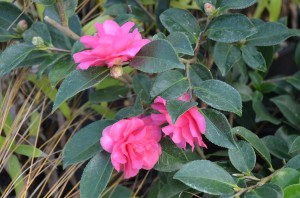Camellias bloom at a time when most trees and shrubs are not flowering. Growing them is no longer a dream for gardeners who do not live in the deep South. A number of “designated zone 6 hardy” cultivars prosper in the Southern Appalachian region (USDA hardiness zones 6 and 7). ‘ShiShi Gashira’ camellia (Camellia hiemalis) is not one listed in the zone 6 group.
Also written ‘Shishigashira’, it is a late fall blooming cultivar that grows 5-6 feet tall and slightly wider than high. Dark pink flowers are mostly 2 1/2 to 3 inches across and bloom from late October into early January. It is rated hardy in USDA hardness zones 7-10, but appears hardy in zone 6-b with protection. It does not bloom out its full bud count before sub-zero nights in December and January shut down flowering.
Foliage is evergreen and does not discolor over our cold winter months. It grows best with part sun or part shade, avoiding most afternoon sun. Dappled sunlight over most of the day will also suffice. Shishigashira is best protected from frigid wintry winds.
Newly planted camellias should be mulched and irrigated during dry periods until established in two years. Camellias dislike overwatering and have proven drought tolerance once established.
Camellia culture is similar to that of rhododendrons. Prepare the ground prior to planting, mixing in generous quantities of organic matter. Camellias require an acidic soil which is well-drained. Feed camellias with an acidic base fertilizer such as Miracle Gro™, Schultz™ or Hollytone™ every 4-6 weeks from March to mid-August.
Shishigashira makes a good fit in most urban gardens planted in a container (zone 7 and warmer) or as an evergreen foundation shrub.


 Posted in
Posted in 
